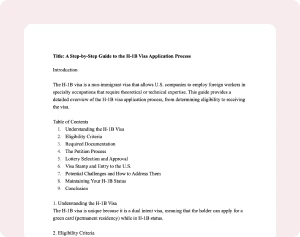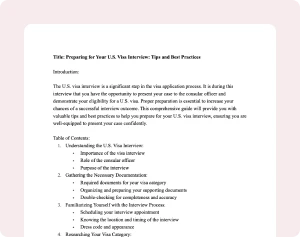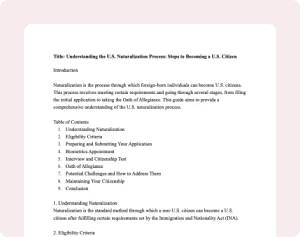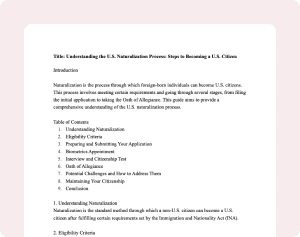Access our library of downloadable resources to help you better understand immigration processes and requirements. Our guides cover topics such as visa application procedures, documentation requirements, and interview preparation.


This comprehensive guide provides a detailed overview of the H-1B visa application process, including eligibility criteria, required documentation, filing procedures, and potential challenges. Learn how to navigate each step of the application process and improve your chances of obtaining an H-1B visa


The visa interview is a crucial part of the U.S. visa application process. This guide offers valuable tips and best practices for preparing for your interview, including gathering the necessary documentation, understanding the role of the consular officer, and practicing common interview questions.


This guide provides a detailed overview of the family-based immigration process in the United States, including eligibility criteria, required documentation, filing procedures, and potential challenges. Learn how to navigate each step of the process and improve your chances of obtaining a family-based visa or green card.


Becoming a U.S. citizen through naturalization is a significant milestone for many immigrants. This guide offers a comprehensive overview of the naturalization process, including eligibility requirements, application procedures, and the citizenship test. Learn how to successfully navigate the path to U.S. citizenship.
Find answers to frequently asked questions about various immigration topics. Our FAQs cover a wide range of subjects, including visa types, application procedures, and eligibility requirements.
The H-1B visa is for foreign workers in specialty occupations who have a bachelor’s degree or higher, while the L-1 visa is for intracompany transferees, allowing employees of multinational companies to transfer to a U.S. branch, affiliate, or subsidiary. Both visas have different eligibility criteria and application processes.
Yes, it is possible to apply for a green card while on a temporary work visa, such as an H-1B or L-1 visa. The process typically involves an employer sponsoring the employee for an employment-based green card, which requires meeting specific eligibility criteria and completing several steps, including labor certification and filing an immigrant petition.
Processing times for U.S. visa applications vary depending on the visa type, the applicant’s country of residence, and the specific U.S. embassy or consulate handling the application. In general, non-immigrant visa processing times can range from a few weeks to several months, while immigrant visas may take several months to over a year.
In some cases, applicants with a pending green card application may be eligible to apply for an Employment Authorization Document (EAD) that allows them to work legally in the United States while awaiting a decision on their application.
A green card grants a foreign national permanent residence in the United States, allowing them to live and work in the country indefinitely. U.S. citizenship, on the other hand, is obtained through the naturalization process and provides additional rights and benefits, such as voting in federal elections and holding a U.S. passport.
If you have a pending green card application and need to travel outside the United States, you may be eligible to apply for Advance Parole, a travel document that allows you to leave and re-enter the country without abandoning your application. It is important to obtain Advance Parole before departing the United States to avoid complications with your green card application.
Explore our glossary of common terms and concepts in immigration law. This comprehensive resource is designed to help you better understand the language and terminology used in immigration processes.
1717 N Street Nw - Ste 1 Washington, DC, 20036
Tel +1 (407) 490-3132
ddad9100 Conroy Windermere Rd Ste 200, Windermere, FL 34786
324 Wyss Street, Johnstown, CO 80534
Tel +1 (407) 490-3132
Rua Estela 515, Bloco A, 1 andar, Paraíso - CEP 04011-002
Tel (11) 5087-4810
SRTVS, Q. 701 - Lote 4 - Bloco O - Sl. 203 - Centro Multiempresarial CEP 70340-000 - Brasília / DF
Tel (61) 3967-3431
Rua Torquato Bahia, n° 04 - Sl. 509 - Comércio - CEP 40015-110 Salvador / BA
(71) 3242 0769
© 2024 Steiner, Kleim & White. All rights reserved.
Please note that the information provided is for general informational purposes only and should not be considered legal advice. Each case is unique, and we strongly encourage you to consult with one of our team member to discuss your specific situation.